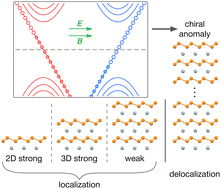Layer-controlled evolution of electron state in the silicene intercalation compound SrSi2†
Abstract
Silicene, a Si-based analogue of graphene, holds a high promise for electronics because of its exceptional properties but a high chemical reactivity makes it a very challenging material to work with. The silicene lattice can be stabilized by active metals to form stoichiometric compounds MSi2. Being candidate topological semimetals, these materials provide an opportunity to probe layer dependence of unconventional electronic structures. It is demonstrated here that in the silicene compound SrSi2, the number of monolayers controls the electronic state. A series of films ranging from bulk-like multilayers down to a single monolayer have been synthesized on silicon and characterized with a combination of techniques – from electron and X-ray diffraction to high-resolution electron microscopy. Transport measurements reveal evolution of the chiral anomaly in bulk SrSi2 to weak localization in ultrathin films down to 3 monolayers followed by 3D and 2D strong localization in 2 and 1 monolayers, respectively. The results outline the range of stability of the chiral state, important for practical applications, and shed light on the localization phenomena in the limit of a few monolayers.



 Please wait while we load your content...
Please wait while we load your content...